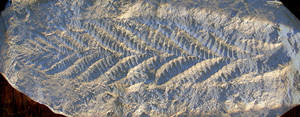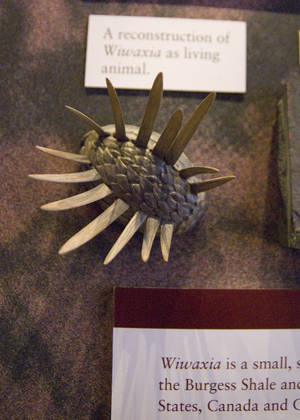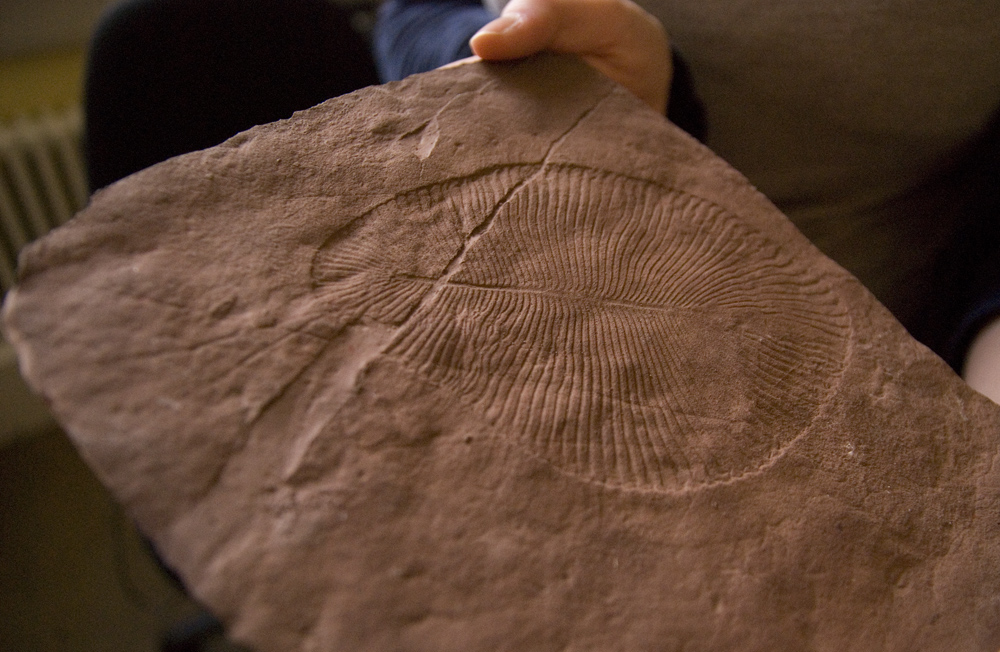Explosive diversity
Interview with
Sarah - It's not until around 3 billion years later that signs of more complex life starts to show up in the fossil record, during a period called the Ediacaran...
 Alex - The first organisms we see at the base of the Ediacaran period are mostly algal things, little filaments and bush-shaped algal fronds. They're around 600-580 million years ago.
Alex - The first organisms we see at the base of the Ediacaran period are mostly algal things, little filaments and bush-shaped algal fronds. They're around 600-580 million years ago.
Sarah - Alex Liu from the University of Cambridge
Alex - And then around 580 million years ago just after a final large glacial event that seems to have been global in scale, we have organisms that can reach up to 2 metres or so in diameter or length. They're seen first in deep water settings, deep marine oceans around Newfoundland and in the UK today in Leicestershire, in Charnwood forest. And then as we go into younger rocks we start seeing them in places like the White Sea in Russia and in Australia in the Flinders Rangers and they're in quite shallow marine environments.
Sarah - Why the sudden appearance of diversity in the fossil record? Well, one argument is that the oxygen levels in the atmosphere and the oceans reached a threshold level, which allowed organisms to evolve to become larger and more complex. And that process could have driven further diversification...
Martin - One argument for what's change is that the arrival of animals completely reinvented the ocean ecosystems.
Sarah - Martin Smith is a researcher at the department of Earth Sciences in Cambridge...
Martin - So once you get animals feeding on these tiny little algae and unicellular  organisms they can start to squash together lots of algae and compress them into faecal pellets and basically poo algal remains to the sea floor. So as algae would have died and dissolved near the surface of the oceans now we're transporting lots of organic matter to the sea bed.
organisms they can start to squash together lots of algae and compress them into faecal pellets and basically poo algal remains to the sea floor. So as algae would have died and dissolved near the surface of the oceans now we're transporting lots of organic matter to the sea bed.
So that has two really revolutionary changes. First of all you're sucking carbon out of the atmosphere. Co2 was being fixed by photosynthesis by these algae, then dissolving and re-released. Now we've got a huge store of carbon in the ocean sediments taking Co2 out of the atmosphere and locking it up in the sedimentary record.
And that's going to change the atmospheric chemistry. The other affect that all this organic carbon on the sea floor is going to have is its now a food source and it now means that rather than a completely barren and empty sea floor you've got the potential for animals, like worms, to come along and start feeding on this organic matter on the sea floor.
Once you've got a new food source you've got great new opportunities and perhaps that contributed to diversification of animal life.
Sarah - But, this early animal life, wasn't necessarily life as we would recognise it today. Alex Liu.
Alex - In terms of their shapes they do seem very different to anything we've seen before or since. But saying that, some members of this large and diverse group do appear to possess traits and characteristics that make it seem that they might be animals.
The possible ctenophores that's been described from China, possible sponges from Australia. There are suggested echinoderms from Australia again. But all of these possible animals come from younger deposits in the latest Ediacaran around 555 million years ago. Everything before that is far more complicated and is much harder to link to know organisms.
 Sarah - So by around 555 million years, there are potential signs of some organisms we may recognise today. But over the next few tens of millions of years, we start to see some even more weird and wonderful organisms appear in the fossil record, during a period known as the Cambrian Explosion. We have the first evidence of complex burrowing behaviour, and the first appearance of shells and spines.
Sarah - So by around 555 million years, there are potential signs of some organisms we may recognise today. But over the next few tens of millions of years, we start to see some even more weird and wonderful organisms appear in the fossil record, during a period known as the Cambrian Explosion. We have the first evidence of complex burrowing behaviour, and the first appearance of shells and spines.
Martin - A little bit after the Cambrian explosion, 510 million years ago or so, you have these really exceptional fossil sites where an entire ecosystem has been mummified and you see not just the bones but you see all the soft parts. You see the eyes, the gills, the fins, completely organisms. So it's interesting to look at shells and bones and that tells you something new has arrived on the scene but what you're really interested in is what's underneath the shells, what's on top of the bones. And that's what you start to see in these really exceptional fossil sites such as the Burgess Shale.
If you look at the complete animals communities that you've reconstructed you see a very complex community. Almost as much diversity and disparity as you see in modern animals communities.
Sarah - And these complex communities contained members of groups that we see today - the molluscs, which includes squid and snails; the arthropods, a group including crabs, lobsters and insects, and even some of our ancient relatives - ancestors of creatures with backbones. Martin Smith again.
Martin - We're starting toe recognise that the Cambrian explosion didn't stop at the end of the Cambrian period but there is a lot of diversification in the next period, the Ordovician period. So this is 60 million years after the start of the Cambrian. It's the Ordovician when we really start to see the sub groups that we recognise today. So we have weird looking molluscs in the Cambrian, we have more familiar looking molluscs in the Ordovician. The Cambrian is a bit like looking through blurry glass at modern life. The Ordovician is looking through a clear glass. We look at an Ordovician sea and it doesn't look quite as alien as the Cambrian oceans were.










Comments
Add a comment